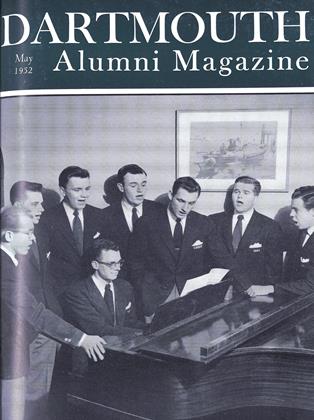byHugh Morrison '26. Oxford UniversityPress; 1952; 634 pages; $12.50.
Dartmouth men who have experienced the distinguished quality of Hugh Morrison's lectures in Carpenter Hall will be delighted to learn that high critical acclaim has greeted the recent publication of his book, EarlyAmerican Architecture. With its publication, this book becomes the only one in the growing field of American architectural history, to trace comprehensively the origins and development of our country's architecture from 1565 to 1848. A book of its kind, for teaching and research purposes, has been sorely needed for years, and its satisfaction of this need, apart from its many other merits, makes it an important achievement.
Early American Architecture is characterized by logic and clarity of organization. Beginning with a discussion of style, it quite properly traces the origins of our first buildings to the old world. The ingenious building techniques of the Colonial carpenter—too long an unsung American hero—are accurately and appreciatively described. The significant contributions of New England to our architectural development, are, needless to say, thoroughly discussed. Readers living beyond the limits of New England will be gratified to find that important sections are devoted to the buildings of the Middle and Southern Colonies, and to the Spanish influence in Florida, the Southwest, and California, while a chapter on French Colonial architecture in the Mississippi Valley will make this an appealing book for those who live there. The wealth of illustrations is unique, and the frequent inclusion of work by such distinguished architectural photographers as Samuel Chamberlain and Wayne Andrews is indicative of the book's high artistic merit.
Morrison's book is based upon years of careful and uncompromising scholarship, but the reader will not find it a tedious relation of facts; its style is lively, piquant and warmly personal. By judiciously selecting for principal discussion only those monuments which best represent the style, period and region under discussion, Morrison has left space to describe many fascinating and hitherto ignored aspects of American architecture. The windmills of Cape Cod, the handsome brick "necessaries" of Virginia, and the aqueducts and fountains of California missions are only a few of the lesser-known but important items in our architectural heritage that are discussed. The description of the early buildings of Dartmouth, and many other colleges, will be of particular interest to the readers of this review.
Both scholar and student will find in EarlyAmerican Architecture the most comprehensive and reliable treatment to date of the first two and one-half centuries of American building; the layman interested in investigating the beginnings and development of our country's architecture will find this book delightful and informative.
 View Full Issue
View Full Issue
More From This Issue
-
 Class Notes
Class Notes1918
May 1952 By ERNEST H. EARLEY, DONALD L. BARR, RICHARD A. HOLTON -
 Class Notes
Class Notes1929
May 1952 By F. WILLIAM ANDRES, EDWIN C. CHINLUND, GEORGE B. REDDING -
 Article
ArticleAshurnazirpal's Story
May 1952 By DONALD P. HANSEN '53 -
 Class Notes
Class Notes1917
May 1952 By KARL W. KOENIGER, DONALD BROOKS, HOWARD A. STOCKWELL -
 Article
Article25 Years After
May 1952 By JAMES D. BINDER '52 AND THOMAS L. PAPST '52 -
 Article
ArticleThe Undergraduate Year
May 1952 By KENNETH J. ROMAN JR. '52
Books
-
 Books
BooksCLIPPER SHIP MEN
December 1944 By Allan Macdonald -
 Books
BooksGOOD NIGHT, MRS. CALABASH.
JUNE 1963 By CLIFF JORDAN '45 -
 Books
BooksWHEN WE SKI
April 1937 By Herbert F. West '22 -
 Books
BooksFAREWELL TO FOGGY BOTTOM.
DECEMBER 1964 By HON. ROBERT CHARLES HILL '42 -
 Books
BooksTHREE CHILDREN OF THE UNIVERSE, EMERSON'S VIEW OF SHAKESPEARE, BACON AND MILTON.
JANUARY 1968 By MICHAEL ANDREWS '61 -
 Books
BooksHELIX,
October 1947 By Sidney Cox

